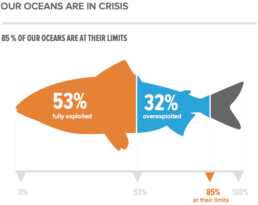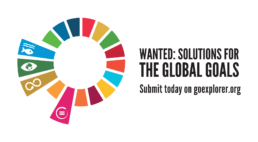Help us discover new solutions that help reach SDG #14 – conserve and sustainably use life in the oceans.
Our oceans, which cover 70% of the planet, regulate our climate and support the livelihoods of 3 billion people, are under threat from pollution, acidification and overfishing. Swimming against the tide isn’t always easy, but we’re looking to map out the newest market opportunities for a better tomorrow. We’re calling on you to help us discover new solutions that are addressing the global goals in need of urgent attention.
Take a deep breath as we dive into Sustainable Development Goal (SDG) 14: conserve and sustainably use the oceans, seas and marine resources for sustainable developments.
We may think we live a long way from the oceans, but we don’t. What we actually do here… has a direct effect on the oceans – and what the oceans do then reflects back on us.
Sir David Attenborough – Naturalist and Broadcaster
There’s a lot that we don’t know about the oceans, but what we do know isn’t good. Research published this week found that all life at sea, that’s over 9 million species (that we know of), is under threat from ocean acidification – one of the big impacts of climate change. One billion people depend on fish for their primary source of protein, but we’re not extracting these resources sustainably, and around the world fish stocks are being depleted using destructive techniques.
We are polluting the oceans at a staggering rate. Excess nutrients from agriculture on land are causing eutrophication and creating thousands of oxygen-starved dead zones around the world. By 2050, it’s estimated that there will be more plastic than fish in the oceans, no thanks to the 8 million tonnes of plastic that we chuck into the sea every year. That plastic then breaks down into tiny fragments, or microplastics, of which there are as many as 51 trillion in our seas – 500 times more than stars in our galaxy. These microplastics are already making their way into our food chains and water supplies, with yet untold impacts on our health.
SDG 14 aims to protect marine environments and sustainably manage their resources. But according to DNV GL’s Future of Spaceship Earth report, we’re not on track to meet these goals. We need a step change to stay afloat; reducing ocean pollution, cutting CO2 emissions and developing new techniques to provide protein from the sea more sustainably.

Where are the opportunities?
But can we do more than just try to keep our head above water? Can we turn these risks into opportunities that deliver value as well as protect and enhance our oceans?
The ‘gross marine product’ is worth $2.5 trillion annually, with fossil fuel extraction, and industrial fishing as two of the major (unsustainable) contributors. By 2030, the global ocean economy is expected to outperform global economy growth rates, with the greatest growth expected in aquaculture, offshore wind, and ship building. The aquaculture market alone is expected to grow by $43 billion over the next five years. In order to realise the full potential of the ocean economy in the long run, we must place a strong emphasis now on creating more sustainable practices and doubling down on preventing pollution. There is a huge opportunity for innovative technologies and solutions to replace damaging single-use plastics, as well as utilising old plastics as a resource for new goods.
This is where we need you!
Do you know about a solution that is contributing to a healthier marine ecosystem? It could be a way to weave old plastics into new materials, a smart method to reuse nutrients before they reach the sea, or an investment fund for sustainable aquaculture. We need your help to identify solutions that are readily available, financially viable, scaleable, have the capacity to improve quality of life, and have a positive environmental impact. We aim to showcase the best submitted solutions online and feature them in an upcoming report to show business around the world that there are commercial opportunities in all SDGs – but especially in the ones currently lagging behind. What solution has just floated into you mind?

Learn more about Sustainia’s crowdsourcing campaign, which seeks to identify solutions addressing the four SDGs (SDG 10, 12, 13 and 14) we are least on track to reach by 2030.
You can also check out the SDG 14 solutions we already feature on Global Opportunity Explorer.
Author: Nic Craig

